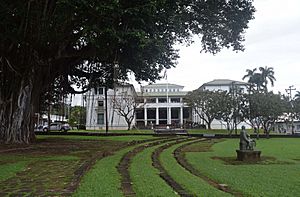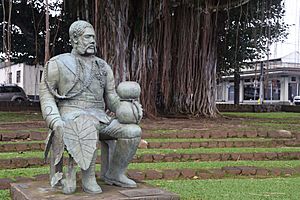Kalakaua Park facts for kids
Kalākaua Park is a special park in Hilo, Hawaii. It's like the main "town square" for the city. Many old and important buildings surround it. The park also has a memorial to remember brave soldiers.
Contents
History of Kalākaua Park
This area started as the first Christian Mission in Hilo in 1825. It was called the Waiakea Mission Station-Hilo Station. Over time, it grew into a central gathering place. It became similar to a New England town square. Important buildings like the courthouse and post office were built around it.
The Federal Building's Story
After Hawaii became part of the United States in 1898, the government needed a new office building in Hilo. Hilo was the second-largest city in the territory. Funds became available in 1913 to build it.
The building was constructed from 1915 to 1917. It was designed by Henry D. Whitfield. The style was Mediterranean neoclassic. It had a post office on the first floor. Federal court offices were on the second floor. In 1936, more sections were added. This made the building into a "U" shape. The courtyard has a flag pole and a fountain. Most postal services moved out in 1978. The courthouse was later changed into federal office spaces.
Exploring Kalākaua Park
The park is named after King David Kalākaua. He was the ruler of the Kingdom of Hawaii from 1874 to 1891. People often called him the "Merrie Monarch." This was because he helped bring back old Ancient Hawaiian songs and dances. The famous Merrie Monarch Festival in Hilo celebrates this culture every year. King Kalākaua dedicated the park around 1877.
The park is located in the heart of Hilo. You can find it between Waianuenue Avenue and Kalakaua Street. It's also near Kinoʻole Street and Keawe Street. In the middle of the park, there is a bronze statue of King Kalākaua. He holds a taro leaf and an ipu (a gourd used in ancient chants). A time capsule was buried here in 1991. It will be opened during the next total solar eclipse visible in Hilo.
Hawaii Island War Memorial
A special white marble monument stands in the park. It remembers those from the Island of Hawaiʻi who died in World War II. The idea for it came about in 1943. It was finished in 1948. Sculptor Roy King designed and carved the monument. Many groups helped pay for it, including veterans.
The monument is 10 feet long, 4 feet wide, and 6 feet high. It has 157 names of World War II heroes from Hawaiʻi Island. A lily pond reflects one side of the monument. This side shows a winged fighting man. He stands for all combat forces. His wings mean protection and peace. People from around the world are shown living together in peace. The back of the monument has a message: "That their spirit may guide us to an ever living peace among all mankind."
The monument was dedicated on October 31, 1948. Hundreds of people attended the ceremony. Two more plaques were added later. One remembers those who died in the Korean War. The other honors those lost in the Vietnam War. Because of these additions, the monument is often called the Korean War Memorial.
Gallery
Images for kids








